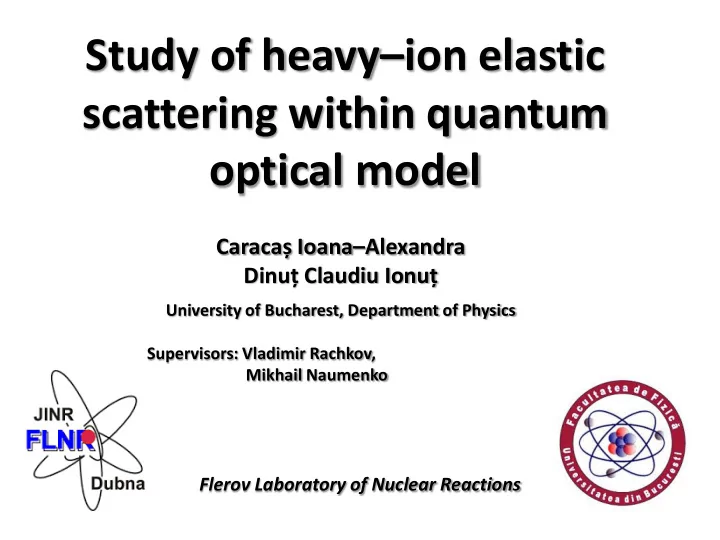

Study of heavy – ion elastic scattering within quantum optical model Caracaș Ioana– Alexandra Dinuț Claudiu Ionuț University of Bucharest, Department of Physics Supervisors: Vladimir Rachkov, Mikhail Naumenko Flerov Laboratory of Nuclear Reactions
Contents Introduction • Project description • Cross section I. Theoretical Part • Optical model of the elastic scattering of nuclei • The optical aspects of quantum scattering - Fresnel diffraction - Fraunhofer diffraction II. Practical part • NRV knowledge base • Description of the elastic scattering of 4 He + 58 Ni and 4 He + 209 Bi at different energies Conclusions
Project description • Aim of the project: Study of the behavior of the elastic scattering differential cross section for different energies and different projectile-target combinations • Steps: 1. Studying of the elastic scattering theory and quantum optical model 2. Derivation of expressions for • partial wave expansion of a plane wave • relation between the elastic cross section and phase shifts • a relation between the scattering amplitude and the phase shifts 3. Digitizing experimental data from the graphs of articles using GSYS program 4. Checking the correctness of digitizing by comparing the results with the experimental graphs 5. Importing data in the NRV optical model codes 6. Determining the parameters of the optical model potential 7. Interpreting the results
Cross section • Interaction of particles is usually described by the cross section s : effective area of interaction Typical units: 1 barn = 10 -28 m 2 = 100 fm 2 Typical units: barn/steradian
Optical model (OM) of the elastic scattering of nuclei • OM is based on solution of time-independent Schr ӧ dinger equation : 2 2 ( ) ( ) E k > 0 ( , ) ( , ) V r k E r k OM k 2 with phenomenological Optical Potential: and boundary condition at infinity: Scattering amplitude
Optical model (OM) of the elastic scattering of nuclei 1. Partial wave decomposition: 2. Numerical solution of the radial Schrodinger equation (Numerov method) with certain boundary conditions for calculation of partial wave functions and differential cross section.
Coulomb (Rutherford) Scattering: V OM = V C Coulomb scattering amplitude: Rutherford law
Coulomb + Nuclear Scattering: V OM = V C + V N
The optical aspects of quantum scattering Fresnel scattering negligible dominates • Bombarding energy around the Coulomb barrier • Coulomb interaction dominates ( η > >1) • “ Illumination region”: interference pattern • “Shadow region”: strong absorption
The optical aspects of quantum scattering Fraunhofer scattering dominates negligible
Practical part NRV knowledge base http://nrv.jinr.ru The NRV web knowledge base is a unique interactive research system: • Allows to run complicated computational codes • Works in any internet browser • Has graphical interface for preparation of input parameters and analysis of output results • Combines computational codes with experimental databases on properties of nuclei and nuclear reactions • Contains detailed description of models
Practical part http://nrv.jinr.ru Optical Model calculation with NRV OM code Main steps of calculation: Physical • Set projectile and target parameters (mass, spin, etc) • Set the incident energy • Set the parameters of the OM potential
Practical part http://nrv.jinr.ru Optical Model calculation with NRV OM code Main steps of calculation: Numerical • Set the radial step for integration • Set the maximum radius R for integration • Set the maximum angular momentum L
OM potential parameters System E lab V 0 r V a V W 0 r w a w (MeV) (MeV) (fm) (fm) (MeV) (fm) (fm) 4 He + 58 Ni 8.1 - 75 0.9 0.49 -8.5 1.37 0.75 9.6 -75 0.96 0.49 -23.5 1.37 0.583 25 -75.3 1.051 0.655 -9.5 1.2 0.75 4 He + 209 Bi 12 -69.805 0.902 0.7 -8.535 1.666 0.48 22 -74 1.1 0.68 -19.55 1.2 0.6 69.5 -72.151 1.091 0.626 -10.562 1.257 0.818
Practical part Description of the elastic scattering of 4 He + 209 Bi at different energies Pure Rutherford Fresnel scattering Fraunhofer scattering scattering η = 11,145 η = 6,27 η = 15.09 Transition from classical (optical) picture to quantum picture * ) Experimental data from 1) P. Sighn et al., Phys. Rev. C 43 (1993), 1867; 2) A.R. Barnett, J.S. Lilley, Phys. Rev. C 9 (1974), 2010.
Practical part Description of the elastic scattering of 4 He + 58 Ni at different energies Close to Rutherford Fresnel scattering Fraunhofer scattering Scattering η = 5,692 η = 3,527 η = 6,196 Transition from classical (optical) picture to quantum picture *) Experimental data from 1) L.R. Gasques et al., Phys. Rev. C 67 (2003), 024602 ; 2) F. Ballester et al., J. Phys. G 13 (1987), 1541.
Conclusions • We studied the elastic scattering theory and the Optical Model. • We derived the expressions for – partial wave expansion of a plane wave, – a relation between the elastic cross section and phase shifts – a relation between the scattering amplitude and the phase shifts • We applied the NRV OM code to study elastic scattering of 4 He + 58 Ni and 4 He + 209 Bi at different energies • Good agreement between calculation results and experimental data was achieved. • Correctness of the results is also justified by their correlation with optics.
Recommend
More recommend